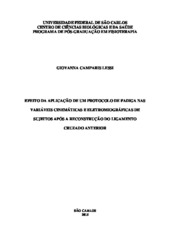| dc.contributor.author | Lessi, Giovanna Camparis | |
| dc.date.accessioned | 2016-06-02T20:18:24Z | |
| dc.date.available | 2015-03-13 | |
| dc.date.available | 2016-06-02T20:18:24Z | |
| dc.date.issued | 2015-02-24 | |
| dc.identifier.citation | LESSI, Giovanna Camparis. Efeito da aplicação de um protocolo de fadiga nas variáveis cinemáticas e eletromiográficas de sujeitos após a reconstrução do ligamento cruzado anterior. 2015. 110 f. Tese (Doutorado em Ciências Biológicas) - Universidade Federal de São Carlos, São Carlos, 2015. | por |
| dc.identifier.uri | https://repositorio.ufscar.br/handle/ufscar/5183 | |
| dc.description.abstract | The incidence of anterior cruciate ligament (ACL) injury in female athletes is higher compared to men in the same sports activity. Subjects who have undergone ACL reconstruction show biomechanical changes that may predispose to a second injury. In addition, the muscular fatigue can increase the ACL injury risk. However, few studies have evaluated the effects of muscular fatigue in the kinematics and muscle activation in patients with ACL reconstruction, and no studies had compared the effects between men and women who undergoing reconstruction. Thus, the aim of this thesis was to evaluate the effects of muscular fatigue on the trunk, pelvis and lower limb kinematics, as well as the lower limb muscle activation during single-leg landing between two distinct groups of subjects, healthy recreational athletes and patients who have undergone ACL reconstruction. We also aim to compare the differences of the effects of fatigue between healthy men and women, and between men and women with ACL reconstruction. This thesis is divided into three studies, in which were performed kinematic analysis of the trunk, pelvis, hip and knee and electromyography of the gluteus maximus, gluteus medius, vastus lateralis and biceps femoris, during a singleleg landing, before and after a fatigue protocol. The first study compared healthy female and male recreational athletes; the second study compared recreational athletes with ACL reconstruction to a healthy control group, and the third study compared men and women with ACL reconstruction. The first study showed that fatigue caused changes in knee kinematics that could predispose healthy women to ACL injury. The second study found that fatigue can alter the kinematics and muscle activation, but these changes were not different between healthy subjects and patients who have undergoing ACL reconstruction. Finally, the third study showed that fatigue leads to kinematic changes that may predispose women who underwent ACL reconstruction to a second injury. | eng |
| dc.description.sponsorship | Financiadora de Estudos e Projetos | |
| dc.format | application/pdf | por |
| dc.language | por | por |
| dc.publisher | Universidade Federal de São Carlos | por |
| dc.rights | Acesso Aberto | por |
| dc.subject | Ligamento cruzado anterior | por |
| dc.subject | Joelhos - ferimentos e lesões | por |
| dc.subject | Fadiga neuromuscular | por |
| dc.subject | Biomecânica | por |
| dc.subject | Anterior cruciate ligament | eng |
| dc.subject | Knee injury | eng |
| dc.subject | Muscular fatigue | eng |
| dc.subject | Biomechanics | eng |
| dc.title | Efeito da aplicação de um protocolo de fadiga nas variáveis cinemáticas e eletromiográficas de sujeitos após a reconstrução do ligamento cruzado anterior | por |
| dc.type | Tese | por |
| dc.contributor.advisor1 | Serrão, Fábio Viadanna | |
| dc.contributor.advisor1Lattes | http://genos.cnpq.br:12010/dwlattes/owa/prc_imp_cv_int?f_cod=K4794266Y0 | por |
| dc.description.resumo | As mulheres atletas possuem maior propensão à lesão do ligamento cruzado anterior (LCA) quando comparadas os homens, praticando uma mesma atividade esportiva. Indivíduos submetidos à reconstrução do LCA possuem alterações biomecânicas que podem predispor à uma segunda lesão. Além disso, a fadiga muscular é um fator que pode aumentar as chances de lesão do LCA. Porém, poucos estudos avaliaram os efeitos da fadiga muscular na cinemática e na magnitude de ativação muscular de indivíduos submetidos à reconstrução do LCA, bem como não há estudos comparando os seus efeitos entre homens e mulheres submetidos à reconstrução. Dessa forma, o objetivo desta tese foi avaliar os efeitos da fadiga muscular na cinemática do tronco, pelve e membro inferior, assim como na magnitude de ativação de músculos do membro inferior durante a aterrissagem de um salto unipodal em dois grupos distintos de indivíduos, atletas recreacionais sadios e submetidos à reconstrução do LCA. Além disso, também foi objetivo comparar as diferenças dos efeitos da fadiga entre homens e mulheres sadios, bem como entre homens e mulheres submetidos à reconstrução do LCA. Esta tese está dividida em 3 estudos nos quais foram realizadas análise cinemática do tronco, pelve, quadril e joelho e análise eletromiográfica dos músculos glúteo máximo, glúteo médio, vasto lateral e bíceps femoral, durante a aterrissagem de um salto unipodal, antes e após a indução de fadiga muscular . O primeiro estudo comparou homens e mulheres atletas recreacionais sadios; o segundo estudo comparou atletas recreacionais com reconstrução do LCA com um grupo controle sadio, enquanto o terceiro estudo comparou homens e mulheres com reconstrução do LCA. O estudo 1 mostrou que a fadiga levou a alterações na cinemática do joelho que podem predispor as mulheres sadias à lesão do LCA. No estudo 2 foi encontrado que a fadiga alterou a cinemática e a magnitude de ativação muscular, mas que essas alterações não foram diferentes entre indivíduos sadios e indivíduos submetidos à reconstrução do LCA. Finalmente, o estudo 3 mostrou que a fadiga resultou em alterações cinemáticas que podem predispor as mulheres submetidas à reconstrução do LCA à segunda lesão. | por |
| dc.publisher.country | BR | por |
| dc.publisher.initials | UFSCar | por |
| dc.publisher.program | Programa de Pós-Graduação em Fisioterapia - PPGFt | por |
| dc.subject.cnpq | CIENCIAS DA SAUDE::FISIOTERAPIA E TERAPIA OCUPACIONAL | por |
